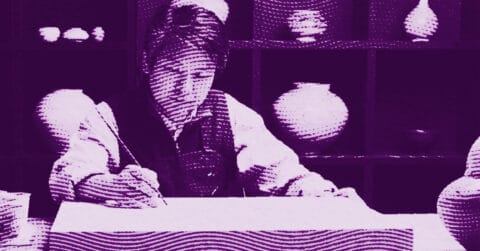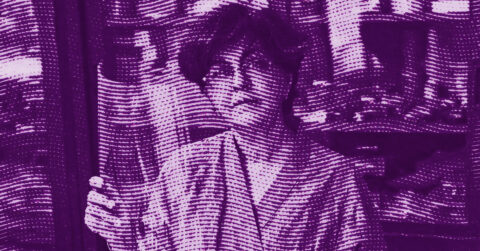Listen to me carefully, you bunch of snobs, you who think you know everything about contemporary art with your convoluted references and pretentious analyses. Sarah Lucas is not a drawing-room artist. No, this woman is a brutal force that tears conventions apart and pulverizes our certainties with the same nonchalance as she would bite into a banana in front of a camera lens.
In her work “Self Portrait with Fried Eggs” (1996), Lucas stares at us with a look that says “So what?” while sporting two fried eggs on her chest. This iconic image is not just a simple provocation; it is a fundamental question about our relationship to the female body in social space. Lucas embodies what the existentialist philosopher Jean-Paul Sartre called “being-for-others,” that keen awareness of being perpetually the object of others’ gaze [1]. But instead of submitting to this gaze, she turns it back on us with a chilling intensity, transforming the viewer into a voyeur conscious of their own participation in the game of objectification.
Lucas’s works navigate an ocean of visual references from British popular culture. Her sculptures “Bunny” (1997), these headless bodies made of padded tights draped over chairs, are not mere parodies of sexual availability. Rather, they evoke what Georges Bataille described as “the formless,” the capacity of art to demote and blur established categories to create a productive unease [2]. The formless in Lucas destabilizes our perceptions and expectations, forcing us to reconsider our preconceived notions about gender, sexuality, and power.
Take “Au Naturel” (1994), this installation where a sagging mattress hosts a pair of melons and a bucket on one side (suggestion of femininity), and a cucumber and two oranges on the other (evoking masculinity). This work is not content to reproduce genitalia as a visual joke; it exposes our collective tendency to reduce humans to their parts while highlighting the fundamental absurdity of this reduction. It is as if Lucas is saying: “Is that what you see when you look at a man and a woman? Seriously?”
There is a profound resonance in Lucas’s work with the Theatre of the Absurd of Samuel Beckett. Her works, like “Two Fried Eggs and a Kebab” (1992), where perishable foods representing breasts and a vagina are placed daily on a table, evoke the futile waiting and desperate repetition found in “Waiting for Godot.” In both cases, the viewer is confronted with a spectacle that seems both comic and deeply melancholic, where human bodies (or their substitutes) are reduced to objects in an existential game devoid of apparent purpose.
But Lucas is not the type to pity our condition. Her sharp humor and absolute rejection of sentimentality bring her closer to the British punk spirit than to French existentialist despair. “A joke is a very serious weapon,” wrote playwright Joe Orton, and Lucas seems to have embraced this philosophy to the core [3]. Her sculptures and installations use humor as a scalpel to dissect social norms and reveal the absurdities of the human condition.
In her photographic self-portraits like “Eating a Banana” (1990), Lucas adopts a deliberately masculine posture while engaging in an act loaded with sexual connotations. By doing so, she blurs the boundaries between genders, embodying what Judith Butler would describe as the performativity of gender, the idea that gender is not an essence but a series of repeated acts that create the illusion of a stable identity. Lucas exposes these mechanisms by deliberately adopting traditionally masculine poses and attitudes while keeping her anatomically female body at the center of the image.
What distinguishes Lucas from many other contemporary artists is her ability to walk the tightrope between feminist critique and joyous celebration of vulgarity. She does not claim to offer solutions to the problems she raises; as she herself has stated: “I am not trying to solve the problem. I explore the moral dilemma by incorporating it.” This approach echoes the thinking of Simone de Beauvoir who, in “The Second Sex”, not only describes the oppression of women but also explores how women can negotiate their freedom within existing structures [4].
Lucas’s more recent sculptures, such as her “Nuds” series, where abstract bodily forms twist and wrap around one another, mark an evolution in her work towards something more primal and visceral. These works seem to seek an authenticity that transcends the play of images and meanings of her earlier pieces. There is here an echo of what Sartre called “authenticity,” an attempt to live and create in accordance with one’s own truth, beyond social expectations and imposed roles.
Since she left London to settle in rural Suffolk, Lucas seems to have developed an interest in shapes and materials that evoke something older and more fundamental than contemporary urban culture. In her “Penetralia” series (2008), direct casts of penises merge with the rough texture of wood and bone, suggesting magical artifacts or archaeological remains. This evolution marks a turning point in her work, as if she is trying to counterbalance the image-saturated world of contemporary culture by invoking the echo of the primitive and the ancient.
Lucas’s recent exhibition “HAPPY GAS” at Tate Britain is not a conventional retrospective but rather, as she herself says, “a drama in four acts.” The characters are all sculptures that somehow incorporate a chair. This theatrical staging of her work recalls the way Beckett structured his plays, as living tableaux where bodies and objects occupy space in a manner that is both comic and deeply unsettling.
The “HAPPY GAS” exhibition exposes with brutal simplicity how Lucas reveals our collective obsessions with sex and death. In the first room, the work “Wanker” (1999), a mechanical arm mounted on buckets that masturbates relentlessly, is placed under an enlarged photograph of Lucas holding a salmon on her shoulder. This play between the still image and mechanical movement creates a tension that is characteristic of her work. As Roland Barthes notes in “Camera Lucida,” photography is always haunted by death, while movement suggests life. Lucas constantly plays with this dialectic, creating works that oscillate between exuberant vitality and memento mori.
What is remarkable about Lucas is her ability to transform everyday objects into powerful metaphors. Chairs, in particular, recur as a leitmotif in her work, serving as stages on which various transgressions are played out. As she explains in the exhibition guide: “The purpose of chairs (in the world) is to welcome the seated human body. They can be diverted to other ends. Generally as support for an action or an object. Changing light bulbs. Wedge a door. Resting. Sex […] My own sculptural intentions are no different.”
Lucas’s relationship with materiality is complex and constantly evolving. Her early works often played on the tension between image and object, as in “Two Fried Eggs and a Kebab”, where food items replaced parts of the body. But over time, her sculptures seem to have freed themselves from this dependence on games of meaning, instead seeking a more direct and visceral material presence. This evolution recalls what the philosopher Maurice Merleau-Ponty called “perceptual faith”, that fundamental trust in direct sensory experience as the basis of our understanding of the world.
In the last room of the exhibition, a car cut in half and partially burned, “This Car’s Going to Heaven” (2018), dominates the space. The hood is raised, revealing the V6 engine of a Jaguar. Cigarettes cover the seats and the hood, forcing a relationship between the two: the slow and deadly harm of smoking linked to the potentially rapid mortality of the car itself. This play between binary characteristics, slow/fast, hard/soft, high/low culture, is a common feature of much of her work.
Lucas uses the cigarette as a recurring motif, playing on its masculine phallic connotations while associating it with the female body. In “Cigarette Tits” (1999), she uses cigarettes to mimic the female form, provoking the viewer to reconsider how women are presented and represented, not only in art but also in mainstream media. She presents inanimate objects in a sexualized way, adopting the “male gaze” to better subvert it through humor.
What distinguishes Lucas from many other feminist artists is her ability to reveal everyone’s complicity in the systems she criticizes. She does not claim to stand outside or above the dynamics of power and objectification she exposes; on the contrary, her work often acknowledges her own participation in these systems. As Simone de Beauvoir wrote: “One is not born, but rather becomes, a woman,” suggesting that our gendered identities are constructed through our ongoing participation in social norms [5].
Sarah Lucas’s work is an invitation to recognize and embrace the contradictions and ambiguities of human experience. She does not offer us easy solutions or comfortable moral positions, but rather a space to confront the most troubling and absurd aspects of our existence. Like Beckett’s character who declares, “I can’t go on, I’ll go on,” Lucas’s art pushes us to acknowledge the absurdity of our condition while finding a form of freedom in that very recognition.
If I mentioned Sartre, Bataille, and Beckett, it is not to impress you, but because Lucas’s work deserves to be placed within this philosophical pantheon. She is not just an artist who shocks to shock; she is a visual philosopher who uses fried eggs, cucumbers, and cigarettes to explore the deepest questions of identity, gender, and human existence. And she does it with a fierce humor that makes these questions not any less serious, but infinitely more vital.
- Sartre, Jean-Paul. “Being and Nothingness”, Éditions Gallimard, Paris, 1943.
- Bataille, Georges. “Documents”, Mercure de France, Paris, 1968.
- Lahr, John. “Prick Up Your Ears: The Biography of Joe Orton”, Bloomsbury, London, 1978.
- Beauvoir, Simone de. “The Second Sex”, Éditions Gallimard, Paris, 1949.
- Ibid.
















